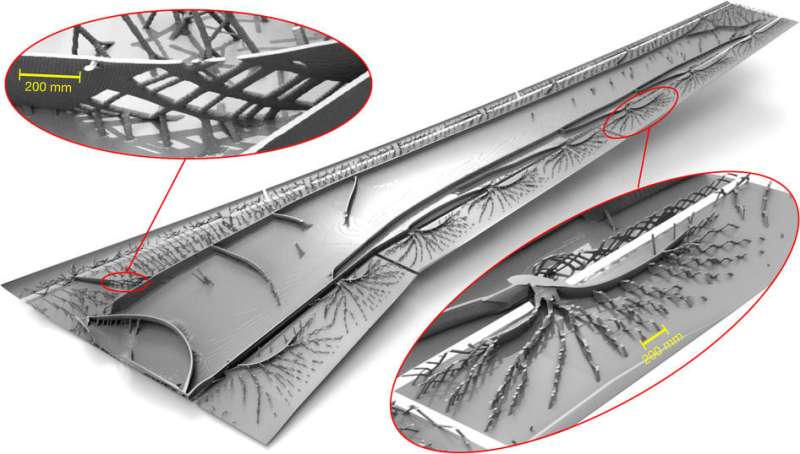October 5, 2017 report
A supercomputer tool that can optimize airplane wing design offers improved detail

(Tech Xplore)—A team of researchers with the Technical University of Denmark has applied an engineering technique in a new way to the design of the interior of an airplane wing. The resulting design is 2 to 5 percent lighter than conventional designs. In their paper published in the journal Nature, the team describes creating a tool to bring the number-crunching power of a supercomputer to a common engineering problem, and what the results suggest about future engineering endeavors. Matthijs Langelaar with Delft University offers a News & Views perspective piece on the work done by the team in the same journal issue.
Over time mathematicians, engineers, computer scientists and researchers in other fields have contributed to optimization methods for the design of new objects, machines and related parts. One such technique is known as morphogenesis, in which a general design is produced and then successful improvements are made over time. Improvements are often made while balancing multiple factors such as performance, cost or weight. Langelaar notes that the technique is, in essence, a process of rearranging material in a given component. Morphogenesis computer programs have been created to speed the process along, but require so much computing power that they are mostly only useful for the design of simple component parts. In this new effort, the researchers have created a tool that can be used on a supercomputer, making it possible to offer much more detail.
Voxels are used when representing three-dimensional objects in a computer, rather than the two-dimensional pixel. As a higher number of smaller pixels offers better screen resolution, a higher number of smaller voxels offers better resolution and detail for three-dimensional objects. Current computers generally have a resolution of five million voxels. The new tool developed by the team in Denmark operates with a resolution of more than a billion voxels.
To demonstrate the effectiveness of their new tool, the researchers applied it to the interior design of an airplane wing. Using 8000 processors running over the course of several days, the computer developed a model that the researchers claim is 2 to 5 percent lighter than current designs. Translated to the real world, they calculate that such a savings in weight would result in a Boeing 777 airplane having wings 200 to 500 kilograms lighter than those in use today which they further calculated would result in a savings of 40 to 200 tonnes of fuel per year.
Unfortunately, actually building the wing developed using the new tool is not technologically feasible at this time, but the results, the researchers suggest, show what is possible for other components.
More information: Niels Aage et al. Giga-voxel computational morphogenesis for structural design, Nature (2017). DOI: 10.1038/nature23911
Abstract
In the design of industrial products ranging from hearing aids to automobiles and aeroplanes, material is distributed so as to maximize the performance and minimize the cost. Historically, human intuition and insight have driven the evolution of mechanical design, recently assisted by computer-aided design approaches. The computer-aided approach known as topology optimization enables unrestricted design freedom and shows great promise with regard to weight savings, but its applicability has so far been limited to the design of single components or simple structures, owing to the resolution limits of current optimization methods1, 2. Here we report a computational morphogenesis tool, implemented on a supercomputer, that produces designs with giga-voxel resolution—more than two orders of magnitude higher than previously reported. Such resolution provides insights into the optimal distribution of material within a structure that were hitherto unachievable owing to the challenges of scaling up existing modelling and optimization frameworks. As an example, we apply the tool to the design of the internal structure of a full-scale aeroplane wing. The optimized full-wing design has unprecedented structural detail at length scales ranging from tens of metres to millimetres and, intriguingly, shows remarkable similarity to naturally occurring bone structures in, for example, bird beaks. We estimate that our optimized design corresponds to a reduction in mass of 2–5 per cent compared to currently used aeroplane wing designs, which translates into a reduction in fuel consumption of about 40–200 tonnes per year per aeroplane. Our morphogenesis process is generally applicable, not only to mechanical design, but also to flow systems3, antennas4, nano-optics5 and micro-systems6, 7.
© 2017 Tech Xplore


















